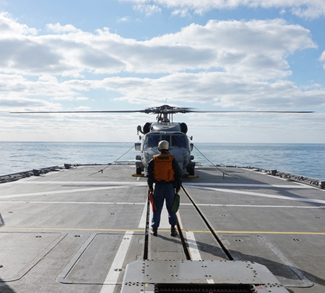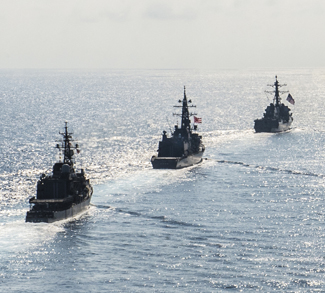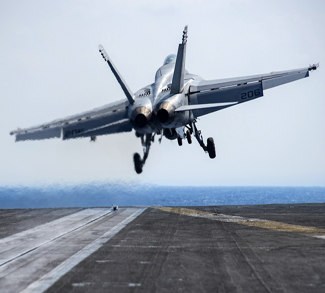In recent years, relations between China and Japan have come under increasing strain amidst the escalation of a decades-old territorial dispute over eight uninhabited islands in the East China Sea. The islands of this contentious archipelago are known as the Senkaku Islands in Japan, and the Diaoyu Islands in China. The islands are of high strategic importance due to their proximity to vital shipping lanes, rich fishing grounds, and extensive oil and gas resources. Talks between the two sides have failed to make any meaningful progress, and the risk of an unintended escalation remains high given China’s continued assertiveness, which has led to Japan adopting an increasingly firm position of its own.
The origins of the dispute can be traced back to 1895, when Japan first claimed sovereignty over the islands and incorporated them into Japanese territory. At the end of the Second World War, a defeated Japan renounced claims to a number of territories including the Senkaku Islands, which then came under US control before being handed back to Japan in 1971. Japan argues that its sovereignty dates back to 19th century maritime surveys which mapped the Islands and asserted Japanese ownership. Tokyo contends that China did not dispute this interpretation until the 1970s, when vast oil reserves were discovered in the area.
China however argues that the islands have been part of its territory since ancient times, when the surrounding waters were used as fishing grounds by Chinese vessels, administered by the then-Chinese province of Taiwan. Based on similar historical arguments, modern-day Taiwan also lays claim to the disputed land features.
Despite these competing claims, the Senkaku Islands are formally a part of Japanese territory. For decades, a private Japanese citizen had owned the islands and the dispute remained relatively low key, with all sides more-or-less accepting the status-quo. However, the situation changed in 2012 when the Japanese government purchased three of the islands, a move that angered China and sparked loud diplomatic protests.
Despite Obama’s expression of support for Japan and rhetorical commitment to maintain a strong presence in the region through a military ‘pivot’ towards the Asia-Pacific, China has not been deterred in the East China Sea.
In the intervening years, tensions have escalated as Chinese coastguard vessels have regularly sailed through the islands’ territorial waters. In addition, there have been numerous occasions where Chinese military aircraft have approached Japanese airspace, prompting Tokyo to scramble jets in response. In November 2013, the situation gained international attention when China announced the creation of a new Air Defense Identification Zone covering the islands, which would require any foreign aircraft to abide by Beijing’s terms. The announcement was described by Japan and the Unites States as a ‘unilateral escalation’ of the dispute.
Discussions aimed at lessening the tensions have only achieved limited success: talks to develop a crisis management mechanism began in 2012, resuming once again in 2015 after stalling on several occasions. However, despite these well-intentioned diplomatic efforts, a mutually-agreeable solution has not been found. The disputes have led to increased political mistrust and rising nationalistic sentiments within East Asia’s two major powers, leading some to predict that the long-standing rivals are edging closer towards military conflict.
The United States has increasingly been drawn in to the dispute due to its security alliance with Japan. Under the terms of the alliance, the U.S. is committed to defending Japan in the event of an attack; a promise which was reaffirmed by President Obama during a 2014 visit to Tokyo. He asserted that the Senkaku Islands were included in the agreement, and reassured Japan of US military support in response to threats to its sovereignty. The East China Sea dispute has put Washington in a difficult position: the US has sought to avoid escalation by reassuring its ally Japan, whilst at the same time remaining cautious of criticizing China directly over the issue.
Despite Obama’s expression of support for Japan and rhetorical commitment to maintain a strong presence in the region through a military ‘pivot’ towards the Asia-Pacific, China has not been deterred in the East China Sea. Beijing has continued to sail vessels close to the contested islands, whilst repeatedly reaffirming its sovereignty claims. As a result, Japan has adopted a more assertive military posture of its own. In December 2015, the country approved its largest ever defense budget of $21bn, with a focus on protecting the islands along its southern frontier. This constitutes an increase of 1.5% from the previous year, representing the fourth-consecutive defense budget increase under conservative Prime Minister Shinzo Abe.
Prime Minister Abe has taken a distinctly more outward-looking approach to defense and foreign policy than his predecessors. He ended a decade of defense cuts upon assuming office in 2012, and has introduced a new law to re-interpret Japan’s ‘pacifist’ constitution. The Japanese military has also sought to modernize its equipment to reflect the new security challenges which it faces in the maritime realm. It is currently in the process of acquiring 17 SH-60K naval patrol helicopters, six F-35 stealth fighter jets, and three Global Hawk drones.
This new military hardware will allow Japan to more effectively monitor outlying territories, whilst the upgraded budget allowance will facilitate the expansion of military bases on the southern islands of Miyakojima and Amami Oshima. However, despite representing the seventh largest defense budget globally, Japan’s military spending still lags far behind that of China, at $66bn. Crucially for Japan however, its closest ally the United States retains the world’s largest military budget at $296bn, and has pledged to re-balance its military to the Asia-Pacific with a focus on building naval capacity, as evidenced by President Obama’s commitment to expand the US Seventh Fleet and deploy 60% of US warships to the region by 2020.
So far, China has refused to back-down from its claims and appears determined to maintain a strong naval presence around the disputed Islands. However, Japan’s hardened security posture – predicated on a more outward-facing military and reinforced by its defense alliance with the United States – is likely to prevent Chinese assertiveness reaching the levels seen in the neighboring South China Sea. Yet the dispute over the Senkaku Islands in the East China Sea is unlikely to go away any time soon. It is reflective of a long-standing regional rivalry between two East Asian superpowers, and is sustained by strong nationalistic sentiments on both sides – a decisive factor which may keep the dispute alive for decades to come.




